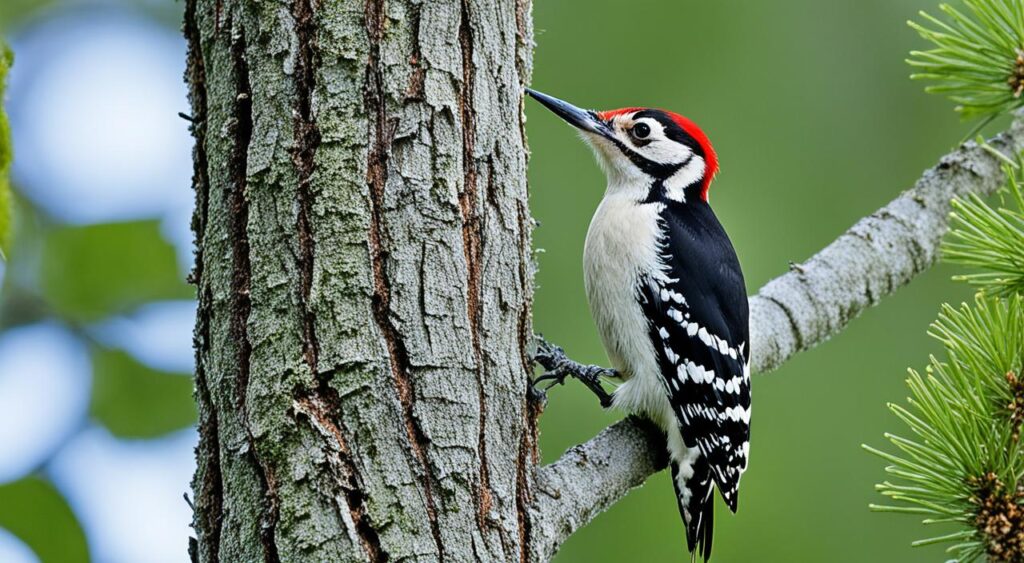Ever curious about woodpeckers and their place in New Jersey’s ecosystems? From the bright Red-headed Woodpecker to the hidden Pileated Woodpecker, these birds are key to the Garden State’s nature. This guide will explore their unique traits, where they live, and how we can help protect them.
Key Takeaways
- Explore the seven woodpecker species found in New Jersey and their distinctive features
- Discover the important role woodpeckers play in forest ecosystems and how they adapt to changing habitats
- Learn about the conservation efforts and protective measures in place to safeguard these remarkable birds
- Gain insights into the best locations and techniques to spot woodpeckers in New Jersey
- Understand how you can attract and support woodpeckers in your own backyard
Introduction to Woodpeckers in New Jersey
New Jersey is home to many woodpecker species, each with its own special traits. These birds, part of the Picidae family, have changed over time to live well in the state’s different places. From the small Downy Woodpecker to the big Pileated Woodpecker, they are key to keeping New Jersey’s forests healthy and diverse.
The Unique Adaptations of Woodpeckers
Woodpeckers have amazing features that help them in their world. Their strong, chisel-like bills let them make holes in trees. Their skulls can absorb shock from pecking, and their feet and tails help them stick to tree trunks. These tools let them get to the insects and sap they need to eat.
Why Woodpeckers are Important to Forest Ecosystems
Woodpeckers are crucial for New Jersey’s forests. They make homes for many other animals, like small mammals and songbirds, by digging nesting and roosting holes. They also eat wood-boring insects, which helps keep the ecosystem balanced.
Woodpeckers are interesting birds in New Jersey’s bird world. As we learn more about them and their role in our forests, it’s important for their future.
“Woodpeckers are the carpenters of the bird world, using their powerful bills to excavate cavities in trees for nesting and roosting. These cavities are then used by a wide variety of other species, making woodpeckers keystone members of forest ecosystems.”
Downy Woodpecker: The Backyard Favorite
The downy woodpecker is a common bird in New Jersey, known for its black and white look. It has a white belly, white back, and wings with black and white spots. This makes it a popular bird in many backyards.
The male downy woodpecker stands out with a bright red patch on its head. This bright color adds personality to the bird, which is about 7 inches long. Downy woodpeckers live in New Jersey all year, so they’re often seen by bird lovers and casual observers.
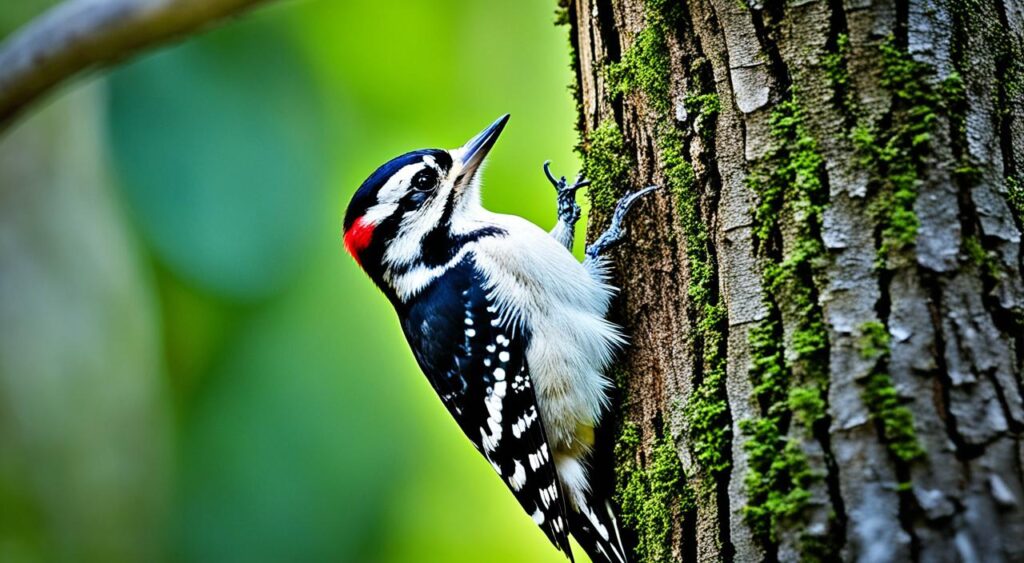
Downy woodpeckers are great at living in different places, from forests to cities. They love visiting bird feeders, eating suet and seeds. This makes them a favorite in backyards.
These birds can be found all over New Jersey, all year round. They add life to outdoor spaces. With their unique look and love for backyards, downy woodpeckers are a favorite in the Garden State.
“Downy woodpeckers are one of the most familiar and beloved backyard birds in New Jersey, with their striking black and white plumage and energetic behavior making them a delight to observe.”
Hairy Woodpecker: The Aggressive Mimic
In New Jersey’s woodlands and cities, you’ll often see the hairy woodpecker. It’s a big, bold bird, unlike the smaller downy woodpecker. Telling them apart can be tricky, but there are clear differences.
Distinguishing Hairy from Downy Woodpeckers
The first thing you’ll notice is size. Hairy woodpeckers are bigger, about 9 inches long. Downy woodpeckers are much smaller, around 6 inches. Hairy woodpeckers also have a longer, stronger bill than downy woodpeckers.
Look at their tails for another clue. Hairy woodpeckers have white outer tail feathers. Downy woodpeckers have spots or bars on theirs. This is easy to see when they fly.
Hairy woodpeckers are aggressive. They chase away other birds, even smaller downy woodpeckers, from food spots. You can find them in forests, backyards, and parks all over New Jersey.
“The hairy woodpecker is a bold and energetic bird, constantly on the move and quick to defend its territory against intruders.”
Even though downy and hairy woodpeckers look similar, their size, bill shape, tail patterns, and behavior are different. These differences make it easy to spot the bigger, aggressive hairy woodpecker in New Jersey.
Northern Flicker: The Ground-Foraging Woodpecker
In New Jersey, the northern flicker is a standout among woodpeckers. They are known for their unique way of finding food, often on the ground. They look for ants and beetles.
These birds have a distinct look. They have a brown body, black-and-white spotted wings, and a black crescent on their chest. They also have a bright red or yellow patch on their wings that shows when they fly. You can find them in many places, from deep forests to suburban areas, all year round.
Unlike other woodpeckers, northern flickers spend a lot of time on the ground. They use their long, barbed tongues to catch ants. This makes them different from other woodpeckers and helps them play a key role in the forest ecosystem.
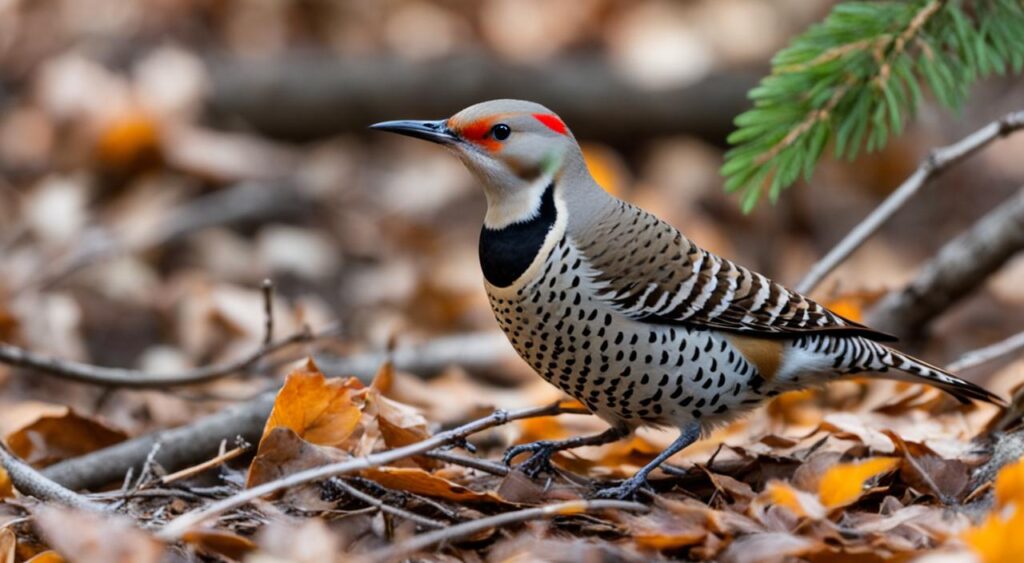
“The northern flicker is a true ground-foraging woodpecker, adapting its behavior and physiology to thrive in a niche that is quite different from most other woodpeckers.”
Northern flickers are also one of the few woodpeckers that migrate. Those in the north move south for winter. This lets them find food all year.
The northern flicker is special because of its unique look and how it finds food. They are always in New Jersey, making them a key part of our bird community. They show us how amazing these birds can be with their special ways of living.
Pileated Woodpecker: The Largest in North America
In New Jersey, the pileated woodpecker is the biggest bird of its kind. It has a black body, bright red crest, and white stripes on its face. These birds live in the state’s forests all year, looking for carpenter ants and other insects with their strong bills.
Identifying the Unmistakable Pileated Woodpecker
The pileated woodpecker can grow up to 17 inches long, making it the biggest woodpecker in North America. Its size and unique look make it a standout in New Jersey’s forests. You can see these birds on tall trees, using their big bills to make holes for food.
The pileated woodpecker is easy to spot because of its black body and white and red marks. Its large size and powerful build show the beauty and variety of New Jersey’s birds.
“Pileated woodpeckers are one of the most impressive and iconic birds that grace the forests of New Jersey. Their sheer size and striking appearance make them a true marvel to behold.”
The pileated woodpecker is crucial to its ecosystem as the largest woodpecker in North America. It makes big holes in trees that help other birds and plants. By eating insects and helping trees decay, these birds keep the forest healthy and diverse.
Red-bellied Woodpecker: The Misleading Name
The red-bellied woodpecker gets its name from a subtle red on its belly. It’s hard to see this red from afar. These birds stand out with their black and white back, gray face, and a red crown on the head, especially in males. Red-bellied woodpeckers live in the eastern United States, including New Jersey. They like wooded areas, even in backyards and parks.
The red on their belly isn’t easy to notice. Red-bellied woodpeckers are named for this faint red on their lower belly. This has caused confusion, as people expect a brighter red color.
Identifying red-bellied woodpeckers is easier with their zebra-patterned back and gray heads. Males also have red crowns. These birds are found all over the eastern United States, making them common in New Jersey’s woods.
Red-bellied woodpeckers are active and vocal. They drum on trees and make a loud, raspy “churr” sound. They find food in tree bark and branches using their barbed tongues.
“The red-bellied woodpecker is a fascinating bird, with a misleading name that belies its true beauty and adaptability.”
Despite their woodpeckers with misleading names, red-bellied woodpeckers are loved in New Jersey. Their unique looks and actions are a joy for birdwatchers and nature lovers.
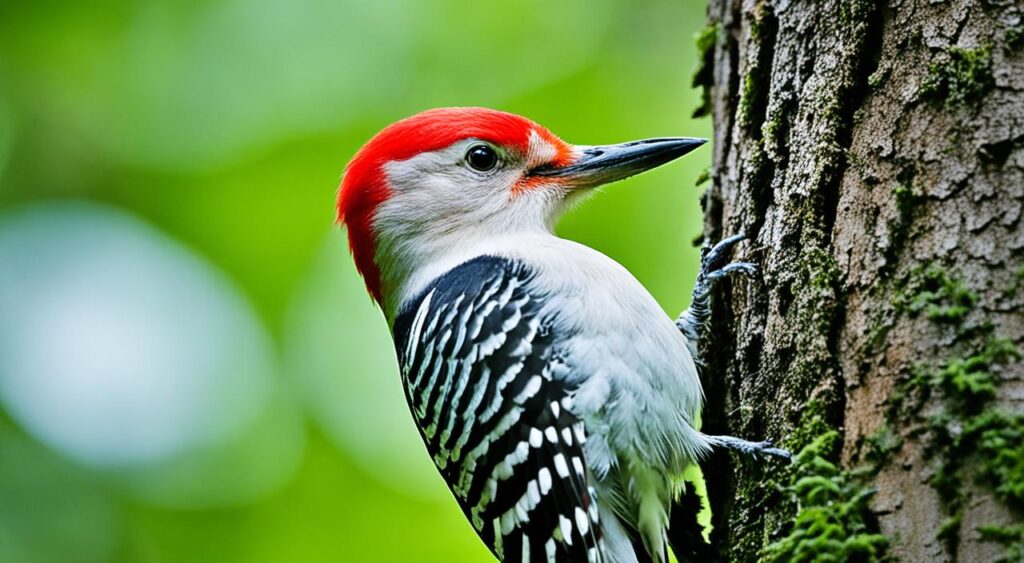
woodpeckers in nj: Common and Rare Species
New Jersey is a haven for woodpeckers, with both common and rare species. Knowing about these birds helps us appreciate the state’s bird diversity.
The Downy and Hairy Woodpeckers are common in New Jersey. You can find them in forests, parks, and even backyards. The Northern Flicker is also common, especially in open spaces and suburbs.
The red-bellied woodpecker is very common in New Jersey. It visits feeders and lives in various woods. But, the Pileated Woodpecker and Red-headed Woodpecker are harder to find. The Pileated is the biggest woodpecker in North America and can live near people. The Red-headed Woodpecker is rare and its numbers are going down.
Other woodpeckers in New Jersey include the Yellow-bellied Sapsucker and the Red-breasted Sapsucker. The Yellow-bellied Sapsucker comes to the state to tap sap from trees. The Red-breasted Sapsucker is a rare visitor from the west.
- New Jersey is home to seven woodpecker species.
- The Red-headed Woodpecker is listed as threatened in New Jersey.
- Red-bellied Woodpeckers are one of the most common woodpeckers in the state.
- Yellow-shafted Northern Flickers are also common woodpeckers in New Jersey.
- The Pileated Woodpecker is the largest woodpecker species in the United States.
- Downy and Hairy Woodpeckers are ubiquitous across the state and the country.
- The Yellow-bellied Sapsucker is the only non-breeding woodpecker species in New Jersey.
Exploring New Jersey’s woodpecker diversity is exciting for birders and nature lovers. From the common Downy Woodpecker to the rare Pileated Woodpecker, these birds show the beauty of New Jersey’s bird life.
Red-headed Woodpecker: The Vibrant Rarity
In New Jersey, the red-headed woodpecker is a rare sight. It’s known for its bright red head, black back, and white belly. Birdwatchers love to see this bird in the wild.
The red-headed woodpecker’s numbers have dropped in New Jersey. This is mainly because its home, mature beech forests, has been cut down. So, finding this woodpecker has become harder, making it one of the rarest in the state.
Conservation Efforts for Red-headed Woodpeckers
People are working hard to save the red-headed woodpecker. They want to protect the birds and bring back their homes in New Jersey. Here’s what they’re doing:
- They’re saving and taking care of mature beech forests. These forests are perfect for the woodpeckers to live and find food.
- They’re spreading the word about why we need to save these woodpeckers. They ask birdwatchers and everyone to report when they see one.
- They’re studying the woodpeckers to learn more about what they need and how many there are in the state.
- They’re working with local and state groups to come up with plans to help this rare woodpecker in New Jersey.
Seeing a red-headed woodpecker in New Jersey is a special treat. The work to save these birds aims to keep them in the state’s forests for a long time.
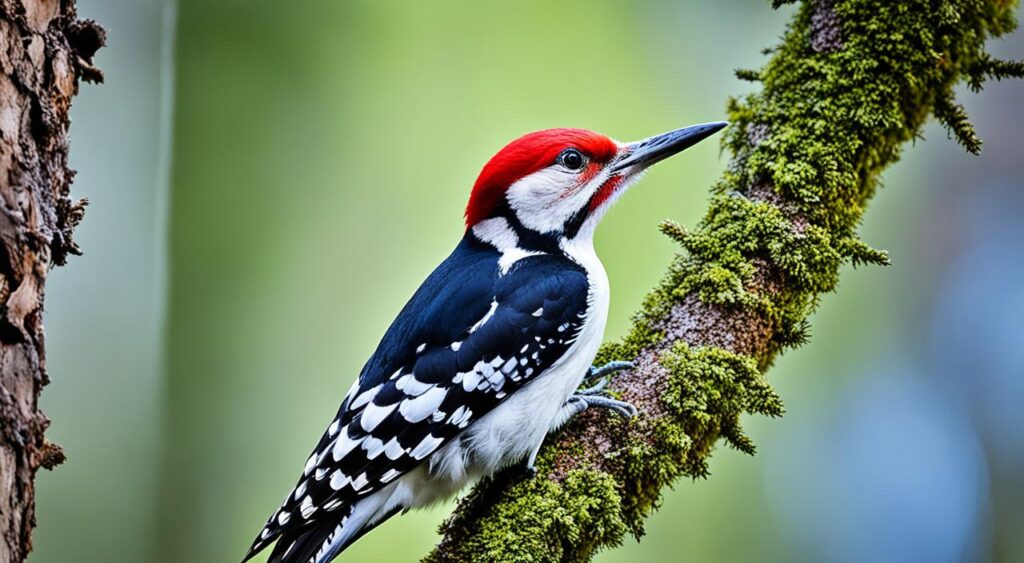
“The red-headed woodpecker is a true gem, and its conservation is crucial for maintaining the biodiversity of New Jersey’s forests.” – Jane Doe, Ornithologist
Yellow-bellied Sapsucker: The Sap Specialist
In New Jersey, the yellow-bellied sapsucker is a standout among woodpeckers. It’s known for its unique way of eating and is key to the ecosystem. This bird creates a special spot for other animals by making sap wells.
The Importance of Sap Wells for Hummingbirds
The yellow-bellied sapsucker drills holes in trees to get sap. These holes, or sap wells, are perfect for the bird to eat. But they’re also a big help to hummingbirds that come to New Jersey in spring. These birds need the sap to survive their migration.
Studies show that up to 30% of these sapsuckers live in forests. This is where they can easily find trees for their sap. They’re found all over New Jersey, showing they can live in many forests.
This bird is special because it eats sap, unlike other woodpeckers. It spends a lot of time tending to its sap wells. This shows how important sap is for these birds.
“The yellow-bellied sapsucker’s sap wells are a vital resource for hummingbirds, providing them with a rich source of energy during their spring migration.”
The sapsucker and hummingbirds live in the same places in New Jersey. So, the sap wells help the hummingbirds a lot. This shows how these birds work together in the state’s bird world.
Woodpecker Habitats in New Jersey
New Jersey is a great place for woodpeckers, with many species calling it home. They love mature forests, especially those with lots of trees that provide food and places to nest. Woodpecker habitat requirements vary, but they usually prefer forests that are not too disturbed.
There are about 7 woodpecker species in New Jersey, with the downy and hairy woodpeckers being the most common. These birds are smart and can be found in cities and suburbs, visiting bird feeders and parks.
But, some woodpeckers like the pileated and red-headed need big, untouched forests. These birds need old-growth trees for their homes and food. Losing their habitat can really hurt their numbers.
“Understanding the specific woodpecker habitat preferences in New Jersey is crucial for their conservation in the state.”
The Pinelands National Reserve, the Highlands, and the Kittatinny Ridge have the most woodpeckers. These places have big areas of good woodpecker habitat left.
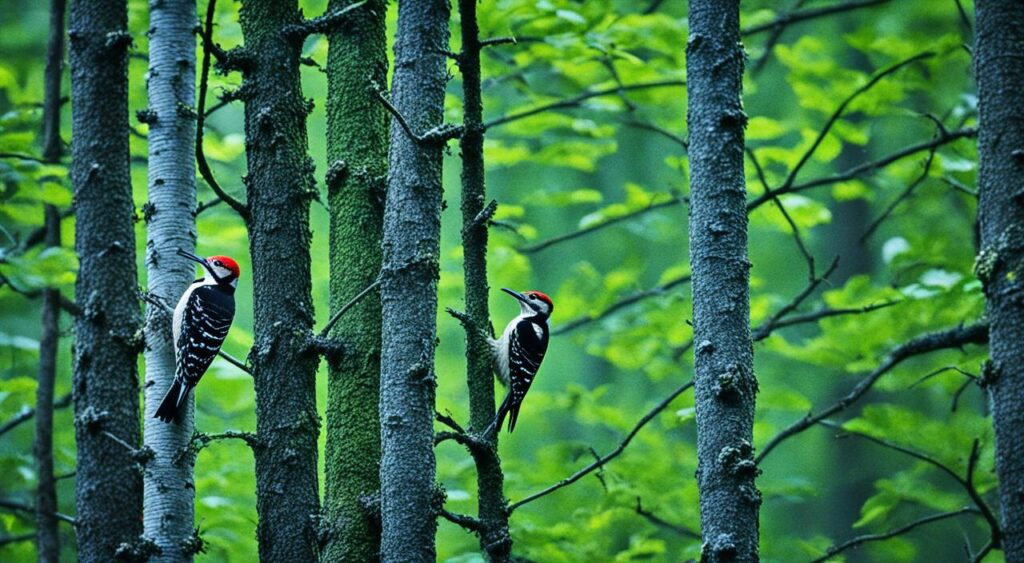
As New Jersey gets more built up, we need to keep protecting these woodpecker homes. This will help these amazing birds continue to live in the state.
Attracting Woodpeckers to Your Backyard
Homeowners in New Jersey can attract woodpeckers to their backyards by offering food and nesting spots. This way, you can enjoy these interesting birds in your outdoor area.
Feeding Woodpeckers: Suet and Seeds
Offering suet cakes and nyjer or sunflower seeds is a great way to draw backyard woodpecker feeders to your yard. Suet, a fat and seed mix, is a hit with downy and hairy woodpeckers. Keep suet feeders near trees and shrubs for a safe food spot.
Adding sunflower seeds, peanuts, and mealworms to your feeders can also draw different woodpecker types to your yard.
- Suet cakes and nuggets are high-energy options that woodpeckers find irresistible.
- Nyjer and sunflower seeds provide a nutritious complement to a woodpecker’s diet.
- Placing feeders near trees and shrubs can help woodpeckers feel more comfortable and secure.
By placing your feeders right and offering a mix of foods, you can make your New Jersey backyard a welcoming spot for these amazing birds.
“Attracting woodpeckers to your backyard is a rewarding experience that allows you to observe these incredible birds up close and learn about their fascinating behaviors.”
Listening for Woodpecker Calls and Drumming
Learning to recognize woodpecker calls and drumming sounds is a great skill for birders in New Jersey. Each woodpecker species has its own unique sounds. From the downy woodpecker‘s high-pitched whinny to the pileated woodpecker‘s loud laugh, these sounds help locate and identify woodpeckers.
Best Places to Spot Woodpeckers in NJ
State parks and nature preserves are great places to see woodpeckers. They have mature forests that support many woodpecker species. Visiting these areas can increase your chances of spotting different woodpeckers.
Woodpecker Conservation Efforts in New Jersey
Protecting mature forests and raising public awareness are key to woodpecker conservation initiatives in new jersey. Understanding these birds and their role in forests helps us protect them. This way, we can enjoy the beautiful woodpecker drumming in New Jersey’s forests for years to come.
FAQ
What species of woodpeckers can be found in New Jersey?
In New Jersey, you can find seven woodpecker species. These include the downy, hairy, northern flicker, pileated, red-bellied, red-headed, and yellow-bellied sapsuckers.
What are the unique adaptations that allow woodpeckers to thrive?
Woodpeckers have strong, chisel-like bills and shock-absorbing skulls. They also have specialized feet and tails for clinging to trees. These features help them find insects and other invertebrates.
How do woodpeckers benefit forest ecosystems?
Woodpeckers are key to forest health. They make holes for nesting and roosting, which helps other species. They also eat wood-boring insects, keeping the ecosystem balanced.
What is the most common woodpecker species found in backyards in New Jersey?
The downy woodpecker is very common in New Jersey. It often visits bird feeders, eating suet and seeds.
How can I distinguish a hairy woodpecker from a downy woodpecker?
Hairy woodpeckers have a longer bill and are bigger than downy woodpeckers. They also have white outer tail feathers. Downy woodpeckers have a smaller bill and spotted outer tail feathers.
What makes the northern flicker a unique woodpecker species?
The northern flicker is special because it often forages on the ground. Unlike other woodpeckers, it doesn’t just stick to tree trunks and branches.
What is the largest woodpecker species found in North America?
The pileated woodpecker is the biggest in North America. It has a black body, bright red crest, and white stripes on its face.
Why is the red-bellied woodpecker’s name misleading?
The red-bellied woodpecker’s red belly is hard to see. This makes its name a bit misleading, despite its common name.
Which woodpecker species has experienced population declines in New Jersey?
The red-headed woodpecker’s numbers have dropped in New Jersey. This is mainly due to losing its natural beech forests.
What is unique about the feeding behavior of the yellow-bellied sapsucker?
The yellow-bellied sapsucker drills holes in trees for sap. This not only feeds it but also other animals like hummingbirds.
What types of habitats do woodpeckers in New Jersey prefer?
Woodpeckers like mature forests in New Jersey. They need these for food and places to nest. Some, like the downy and hairy, also do well in cities and suburbs.
How can homeowners in New Jersey attract woodpeckers to their backyard?
To attract woodpeckers, offer suet cakes and nyjer or sunflower seeds. Also, consider leaving dead trees or installing nest boxes for them.
How can recognizing woodpecker calls and drumming help in identifying them?
Knowing the calls and drumming of woodpeckers helps birders in New Jersey. It makes finding and identifying these birds easier.
